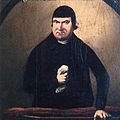| Ebenezer Chapel | |
|---|---|
 The chapel | |
 | |
| 50°58′42″N0°17′10″E / 50.97836°N 0.28608°E | |
| Location | Broad Oak, Heathfield, East Sussex |
| Country | England |
| Denomination | Strict Baptist |
| History | |
| Status | Chapel |
| Founded | 1864 |
| Architecture | |
| Functional status | Active |
| Style | Vernacular |
| Completed | 1864 |
Ebenezer Chapel is a Strict Baptist place of worship in the hamlet of Broad Oak, part of the parish of Heathfield in the English county of East Sussex. The chapel was built in 1864.
Contents
An Independent Baptist congregation was founded here in 1835 by a Horsham-based preacher. The present chapel is aligned to the Gospel Standard movement and was built in 1864. It is timber-framed, partly weatherboarded and rendered, and has been extended several times. Above the entrance there is a gable. [1] [2]
The chapel is licensed for worship in accordance with the Places of Worship Registration Act 1855 and has the registration number 9014. [3]


